The ca. 2785–2805 Ma High Temperature Ilivertalik Intrusive Complex of Southern West Greenland
Abstract
1. Introduction
2. Materials and Methods
3. Results
3.1. Whole Rock Geochemistry
3.2. Zircon Textures
3.3. Zircon U-Pb Isotope Data
3.4. Zircon Hf Isotope Data
3.5. Zircon O Isotope Data
4. Discussion
4.1. Magma Source Considerations
4.2. Magmatic Evolution and Differentiation
4.3. Magma Temperature
4.4. Geodynamic Environment
5. Conclusions
Supplementary Materials
Author Contributions
Funding
Acknowledgments
Conflicts of Interest
References
- Anderson, J.L.; Morrison, J. Ilmenite, magnetite, and peraluminous Mesoproterozoic anorogenic granites of Laurentia and Baltica. Lithos 2005, 80, 45–60. [Google Scholar] [CrossRef]
- Ashwal, L.D. The temporality of anorthosites. Can. Mineral. 2010, 48, 711–728. [Google Scholar] [CrossRef]
- Owens, B.E.; Rockow, M.W.; Dymek, R.F. Jotunites from the Grenville Province, Quebec: Petrological characteristics and implications for massif anorthosite petrogenesis. Lithos 1993, 30, 57–80. [Google Scholar] [CrossRef]
- Emslie, R.F.; Hamilton, M.A.; Thériault, R.J. Petrogenesis of a Mid-Proterozoic Anorthosite-Mangerite-Charnockite-Granite (AMCG) Complex: Isotopic and Chemical Evidence from the Nain Plutonic Suite. J. Geol. 1994, 102, 539–558. [Google Scholar] [CrossRef]
- Goodge, J.W.; Vervoort, J.D. Origin of Mesoproterozoic A-type granites in Laurentia: Hf isotope evidence. Earth Planet. Sci. Lett. 2006, 243, 711–731. [Google Scholar] [CrossRef]
- Andersen, L.J.; Bender, E. Nature and origin of Proterozoic A-type granitic magmatism in the southwestern United States of America. Lithos 1989, 23, 19–52. [Google Scholar] [CrossRef]
- Nutman, A.P.; Bridgwater, D.; Fryer, B.J. The iron-rich suite from the Amitsoq gneisses of southern West Greenland; early Archaean plutonic rocks of mixed crustal and mantle origin. Contrib. Mineral. Petrol. 1984, 87, 24–34. [Google Scholar] [CrossRef]
- Moore, M.; Davis, D.W.; Robb, L.J.; Jackson, M.C.; Grobler, D.F. Archean rapakivi granite–anorthosite–rhyolite complex in the Witwatersrand and basin hinterland, southern Africa. Geology 1993, 21, 1031–1034. [Google Scholar] [CrossRef]
- Nutman, A.P.; McGregor, V.R.; Friend, C.R.L.; Bennett, V.C.; Kinny, P.D. The Itsaq Gneiss Complex of southern West Greenland; the world’s most extensive record of early crustal evolution (3900–3600 Ma). Precambrian Res. 1996, 78, 1–39. [Google Scholar] [CrossRef]
- Reimink, J.R.; Chacko, T.; Stern, R.A.; Heaman, L.M. Earth’s earliest evolved crust generated in an Iceland-like setting. Nat. Geosci. 2014, 7, 529–533. [Google Scholar] [CrossRef]
- Friend, C.R.L.; Nutman, A.P.; McGregor, V.R. Late Archaean terrane accretion in the Godthåb region, southern West Greenland. Nature 1988, 335, 535–538. [Google Scholar] [CrossRef]
- McGregor, V.R.; Friend, C.R.L.; Nutman, A.P. The late Archean mobile belt through Godthåbsfjord, southern West Greenland: A continent-continent collision zone? Bull. Geol. Soc. Den. 1991, 39, 179–197. [Google Scholar]
- Crowley, J.L. Testing the model of late Archean terrane accretion in southern West Greenland: A comparison of timing of geological events across the Qarliit Nunaat fault, Buksefjorden region. Precambrian Res. 2002, 116, 57–79. [Google Scholar] [CrossRef]
- Schiøtte, L.; Compston, W.; Bridgwater, D. U-Pb single-zircon age for the Tinissaq gneiss of southern West Greenland: A controversy resolved. Chem. Geol. 1989, 79, 21–30. [Google Scholar] [CrossRef]
- Næraa, T.; Scherstén, A. New zircon ages from the Tasiusarsuaq terrane, southern West Greenland. Geol. Surv. Den. Greenl. Bull. 2008, 15, 77–80. [Google Scholar]
- Næraa, T.; Scherstén, A.; Rosing, M.T.; Kemp, A.I.S.; Hoffmann, J.E.; Kokfelt, T.F.; Whitehouse, M. Hafnium isotope evidence for a transition in the geodynamics of continental growth after 3.2 Ga. Nature 2012, 485, 627–631. [Google Scholar] [CrossRef] [PubMed]
- Huang, H.; Polat, A.; Fryer, B.J. Origin of Archean tonalite–trondhjemite–granodiorite (TTG) suites and granites in the Fiskenæsset region, southern West Greenland: Implications for continental growth. Gondwana Res. 2012, 23, 452–470. [Google Scholar] [CrossRef]
- Kolb, J.; Kokfelt, T.F.; Dziggel, A. Geodynamic setting and deformation history of an Archaean terrane at mid-crustal level: The Tasiusarsuaq terrane of southern West Greenland. Precambrian Res. 2012, 212–213, 34–56. [Google Scholar] [CrossRef]
- Keulen, N.; Schumacher, J.C.; Næraa, T.; Kokfelt, T.F.; Scherstén, A.; Szilas, K.; van Hinsberg, V.J.; Schlatter, D.M.; Windley, B.F. Meso- and Neoarchaean geological history of the Bjørnesund and Ravns Storø Supracrustal Belts, southern West Greenland: Settings for gold enrichment and corundum formation. Precambrian Res. 2014, 254, 36–58. [Google Scholar] [CrossRef]
- Kokfelt, T.F.; Keulen, N.; Heijboer, T.C.; Næraa, T.; Scherstén, A. Thematic age distribution maps of the Archaean basement of southern West Greenland. Rapp. Grønlands Geol. Unders. 2010, 58, 23–25. [Google Scholar]
- Dziggle, A.; Diener, J.F.A.; Kolb, J.; Kokfelt, T.F. Metamorphic record of accretionary processes during the Neoarchaean: The Nuuk region, southern West Greenland. Precambrian Res. 2014, 242, 22–38. [Google Scholar] [CrossRef]
- Myers, J.S. Granitoid sheets, thrusting, and Archean crustal thickening in West Greenland. Geology 1976, 4, 265–268. [Google Scholar] [CrossRef]
- Hoffmann, J.E.; Svahnberg, H.; Piazolo, S.; Scherstén, A.; Münker, C. The geodynamic evolution of Mesoarchean anorthosite complexes inferred from the Naajat Kuuat Complex, southern West Greenland. Precambrian Res. 2012, 196–197, 149–170. [Google Scholar] [CrossRef]
- Souders, A.K.; Sylvester, P.J.; Myers, J.S. Mantle and crustal sources of Archean anorthosite: A combined in situ isotopic study of Pb–Pb in plagioclase and Lu–Hf in zircon. Contrib. Mineral. Petrol. 2013, 165, 1–24. [Google Scholar] [CrossRef]
- Escher, J.C.; Pulvertaft, T.C.R. Geological Map of Greenland, 1:2,500,000; Geological Survey of Greenland: Copenhagen, Denmark, 1995. [Google Scholar]
- Hall, R.P. The Precambrian Geology of the Kangangup Tasia Area, Fiskenæsset, Southern West Greenland. Master’s Thesis, Council for National Academic Awards at Portsmouth Polytechnic, Portsmouth, UK, 1977. [Google Scholar]
- Gerdes, A.; Zeh, A. Combined U–Pb and Hf isotope LA-(MC)-ICP-MS analyses of detrital zircons: Comparison with SHRIMP and new constraints for the provenance and age of an Armorican metasediment in Central Germany. Earth Planet. Sci. Lett. 2006, 249, 47–61. [Google Scholar] [CrossRef]
- Frei, D.; Gerdes, A. Precise and accurate in situ U–Pb dating of zircon with high sample throughput by automated LA-SF-ICP-MS. Chem. Geol. 2009, 261, 261–270. [Google Scholar] [CrossRef]
- Kemp, A.I.S.; Foster, G.L.; Schersten, A.; Whitehouse, M.J.; Darling, J.; Storey, C. Concurrent Pb–Hf isotope analysis of zircon by laser ablation multi-collector ICP-MS, with implications for the crustal evolution of Greenland and the Himalayas. Chem. Geol. 2009, 261, 244–260. [Google Scholar] [CrossRef]
- Bouvier, A.; Vervoort, J.D.; Patchett, P.J. The Lu–Hf and Sm–Nd isotopic composition of CHUR: Constraints from unequilibrated chondrites and implications for the bulk composition of terrestrial planets. Earth Planet. Sci. Lett. 2008, 273, 48–57. [Google Scholar] [CrossRef]
- Scherer, E.; Munker, C.; Mezger, K. Calibration of the lutetium-hafnium clock. Science 2001, 293, 683–687. [Google Scholar] [CrossRef] [PubMed]
- Söderlund, U.; Patchett, J.P.; Vervoort, J.D.; Isachsen, C.E. The 176Lu decay constant determined by Lu-Hf and U-Pb isotope systematics of Precambrian mafic intrusions. Earth Planet. Sci. Lett. 2004, 219, 311–324. [Google Scholar] [CrossRef]
- Nemchin, A.A.; Whitehouse, M.J.; Pidgeon, R.T.; Meyer, C. Oxygen isotopic signature of 4.4–3.9 Ga zircons as a monitor of differentiation processes on the Moon. Geochim. Cosmochim. Acta 2006, 70, 1864–1872. [Google Scholar] [CrossRef]
- Whitehouse, M.J.; Nemchin, A.A. High precision, high accuracy measurement of oxygen isotopes in large lunar zircon by SIMS. Chem. Geol. 2009, 261, 32–42. [Google Scholar] [CrossRef]
- Wiedenbeck, M.; Hanchar, J.M.; Peck, W.H.; Sylvester, P.; Valley, J.; Whitehouse, M.; Kronz, A.; Morishita, Y.; Nasdala, L.; Fiebig, J. Further characterisation of the 91500 zircon crystal. Geostand. Geoanal. Res. 2007, 28, 9–39. [Google Scholar] [CrossRef]
- Frost, C.D.; Frost, B.R. On Ferroan (A-type) Granitoids: Their Compositional Variability and Modes of Origin. J. Petrol. 2011, 52, 39–53. [Google Scholar] [CrossRef]
- Sun, S.; McDonough, W.F. Chemical and isotopic systematics of oceanic basalts: Implications for mantle composition and processes. In Magmatism in the Ocean Basins; Saunders, A.D., Norry, M.J., Eds.; Geological Society of London: London, UK, 1989; Volume 42, pp. 313–345. [Google Scholar]
- Boynton, W.V. Cosmochemistry of the rare earth elements: Meteoritic studies. In Rare Earth Elements Geochemistry; Henderson, P., Ed.; Elsevier: Amsterdam, The Netherlands, 1984; pp. 63–114. [Google Scholar]
- Szilas, K.; Hoffmann, J.E.; Scherstén, A.; Rosing, M.T.; Windley, B.F.; Kokfelt, T.F.; Keulen, N.; van Hinsberg, V.J.; Næraa, T.; Frei, R.; et al. Complex calc-alkaline volcanism recorded in Mesoarchaean supracrustal belts north of Frederikshåb Isblink, southern West Greenland: Implications for subduction zone processes in the early Earth. Precambrian Res. 2012, 208–211, 90–123. [Google Scholar] [CrossRef]
- Ludwig, K.R. Isoplot/Ex Rev. 3.75; Berkeley Geochronology Centre: Berkeley, CA, USA, 2012; Volume 5. [Google Scholar]
- Szilas, K.; Hoffmann, J.E.; Scherstén, A.; Kokfelt, T.F.; Münker, C. Archaean andesite petrogenesis: Insights from the Grædefjord Supracrustal Belt, southern West Greenland. Precambrian Res. 2013, 236, 1–15. [Google Scholar] [CrossRef]
- Duchesne, J.-C.; Wilmart, E. Igneous charnockites and related rocks from the Bjerkreim–Sokndal layered intrusion (Southwest Norway): A jotunite (hypersthene monzodiorite)-derived A-type granitoid suite. J. Petrol. 1997, 38, 337–369. [Google Scholar] [CrossRef]
- Hoffmann, J.E.; Münker, C.; Næraa, T.; Rosing, M.T.; Herwartz, D.; Garbe-Schönberg, D.; Svahnberg, H. Mechanisms of Archean crust formation inferred from high precision HFSE systematics in TTGs. Geochim. Cosmochim. Acta 2011, 75, 4157–4178. [Google Scholar] [CrossRef]
- Pearce, J.A.; Nigel, B.W.; Tindle, A.G. Trace Element Discrimination Diagrams for the Tectonic Interpretation of Granitic Rocks. J. Petrol. 1984, 25, 956–983. [Google Scholar] [CrossRef]
- Collins, W.J.; Beams, D.; White, J.R.; Chappell, B.W. Nature and origin of A-type granites with particular reference to South-Eastern Australia. Contrib. Mineral. Petrol. 1982, 80, 189–200. [Google Scholar] [CrossRef]
- Whalen, J.B.; Currie, K.L.; Chappell, B.W. A-type granites: Geochemical characteristics, discrimination and petrogenesis. Contrib. Mineral. Petrol. 1987, 95, 407–419. [Google Scholar] [CrossRef]
- Creaser, R.A.; Price, R.C.; Wormald, R.J. A-type granites revisited: Assessment of a residual-source model. Geology 1991, 19, 163–166. [Google Scholar] [CrossRef]
- King, P.L.; Chappell, B.W.; Allen, C.M.; White, A.J.R. Are A-type granites the high-temperature felsic granites? Evidence from fractionated granites of the Wangrah suite. Aust. J. Earth Sci. 2001, 48, 501–514. [Google Scholar] [CrossRef]
- Moyen, J.-F.; Stevens, G. Experimental constraints in TTG petrogenesis: Implications for Archean geodynamics. In Archean Geodynamics and Environments; American Geophysical Union Monographs Series; Benn, K., Mareschal, J.-C., Condie, K.C., Eds.; American Geophysical Union (AGU): Washington, DC, USA, 2006; pp. 149–178. [Google Scholar]
- Watson, E.B.; Harrison, T.M. Zircon saturation revisited temperature and composition effects in a variety of crustal magma types. Earth Planet. Sci. Lett. 1983, 64, 295–304. [Google Scholar] [CrossRef]
- Ferry, J.M.; Watson, E.B. New thermodynamic models and revised calibrations for the Ti-in-zircon and Zr-in-rutile thermometers. Contrib. Mineral. Petrol. 2007, 154, 429–437. [Google Scholar] [CrossRef]
- Harrison, T.M.; Watson, E.B. The behavior of apatite during crustal anataxis: Equilibrium and kinetic considerations. Geochim. Cosmochim. Acta 1984, 48, 1467–1477. [Google Scholar] [CrossRef]

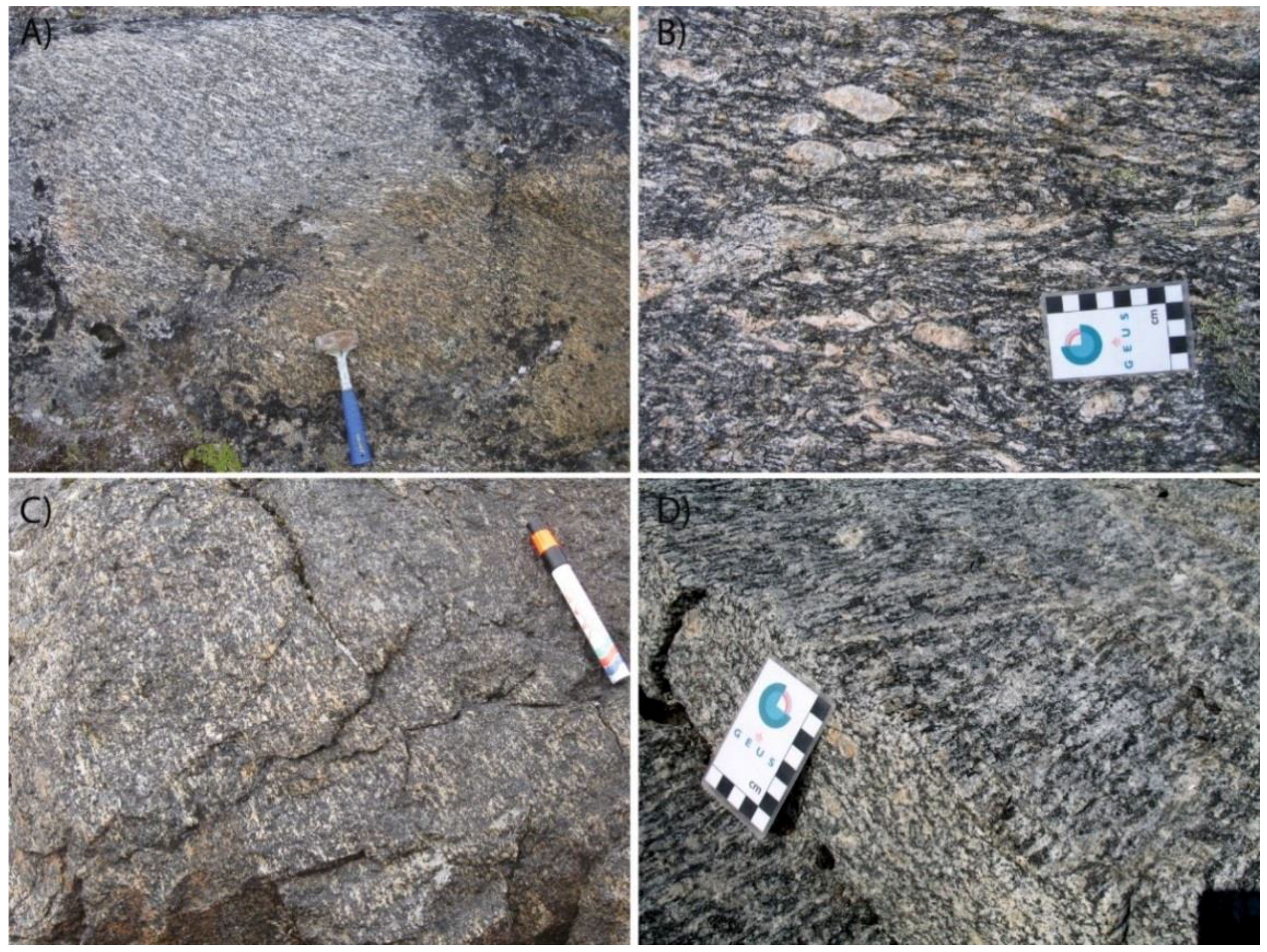

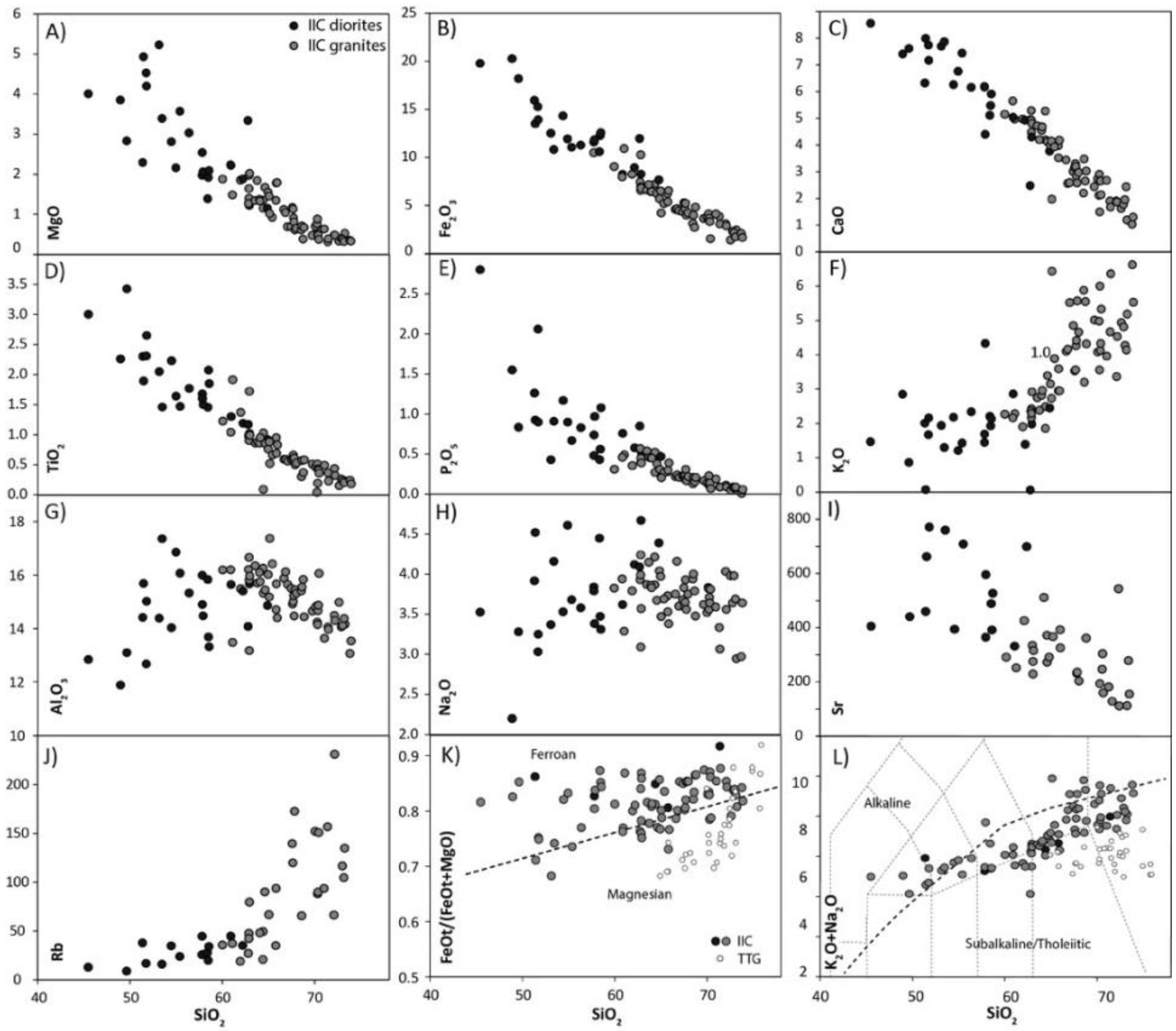
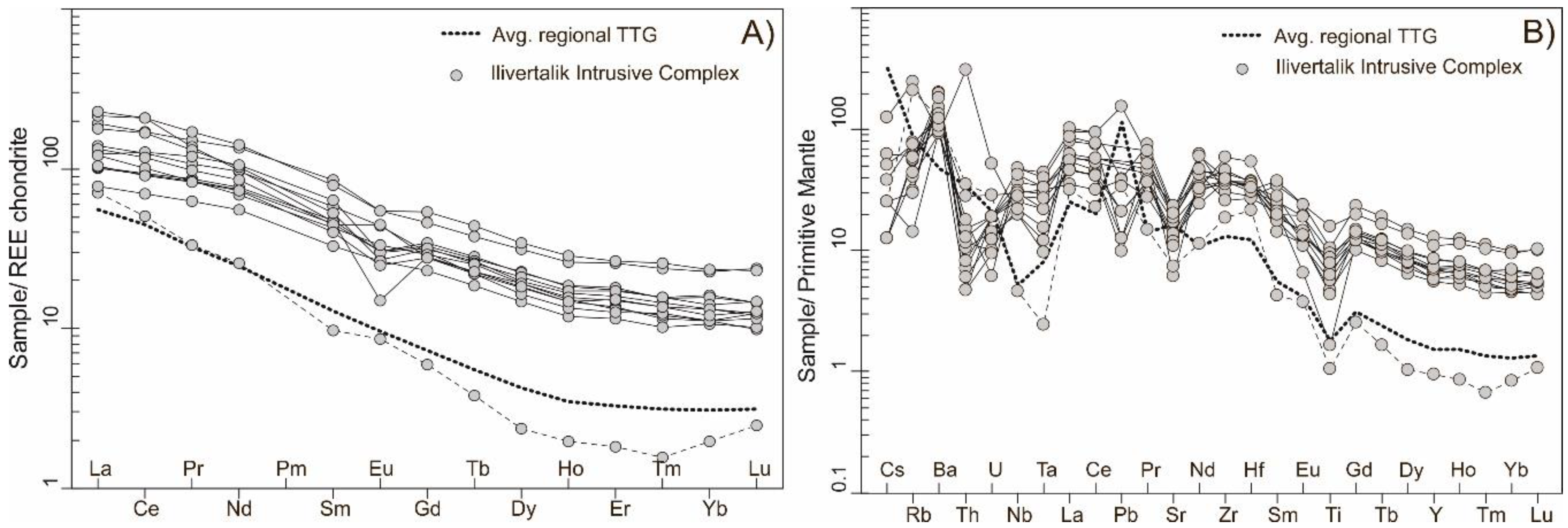
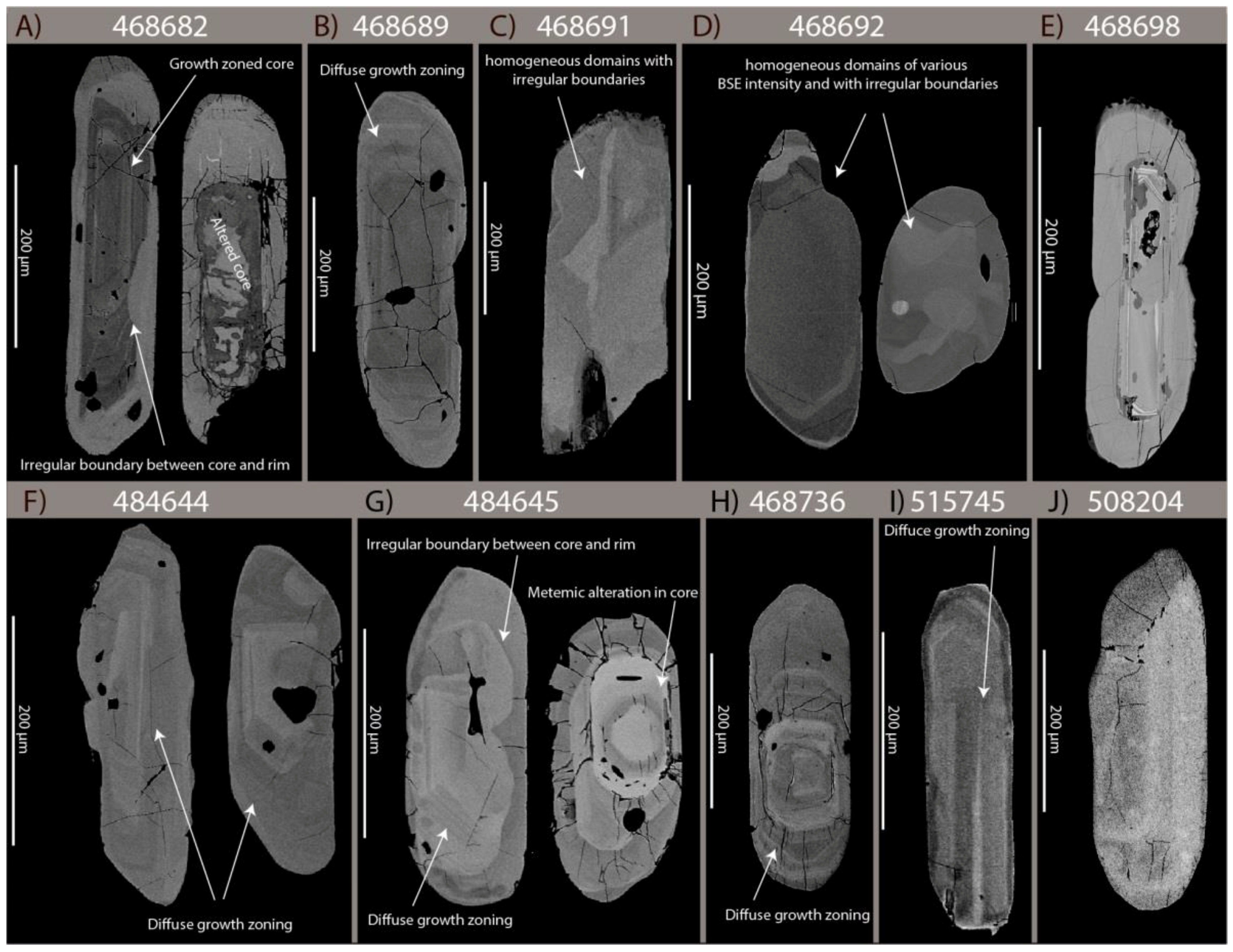

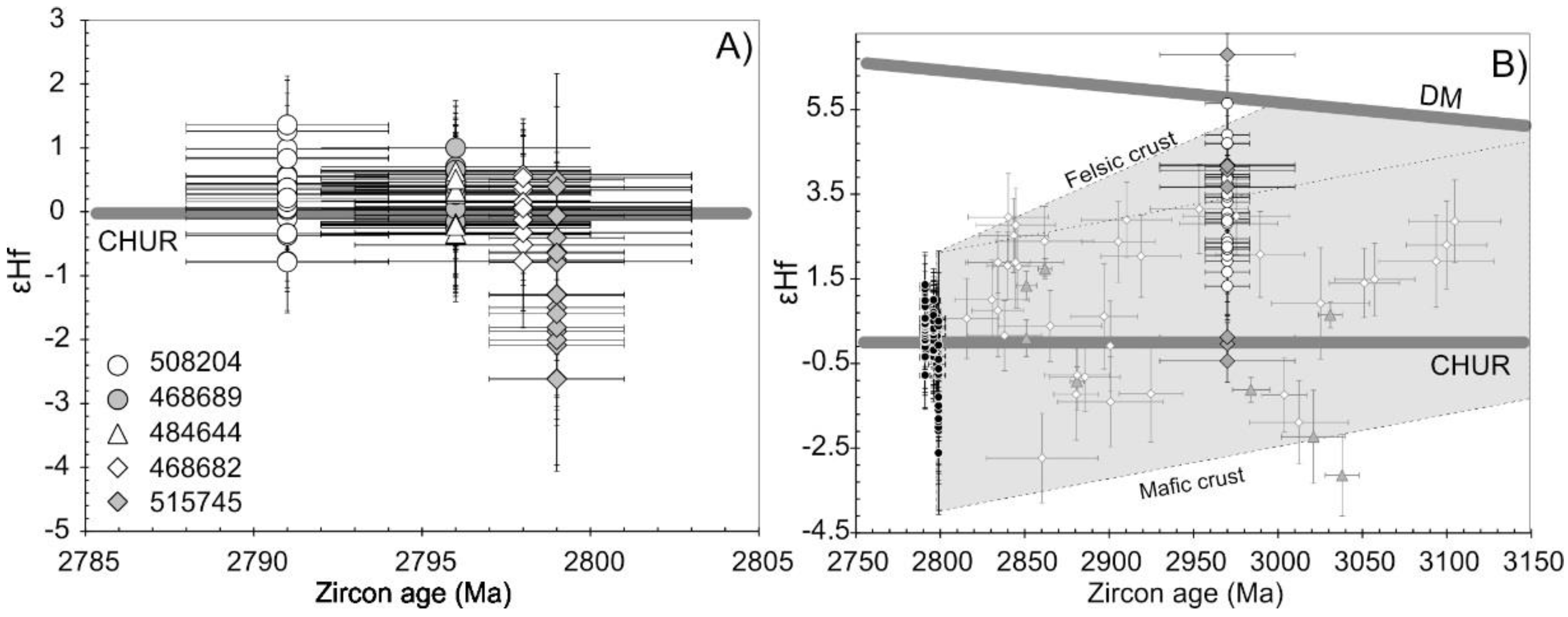
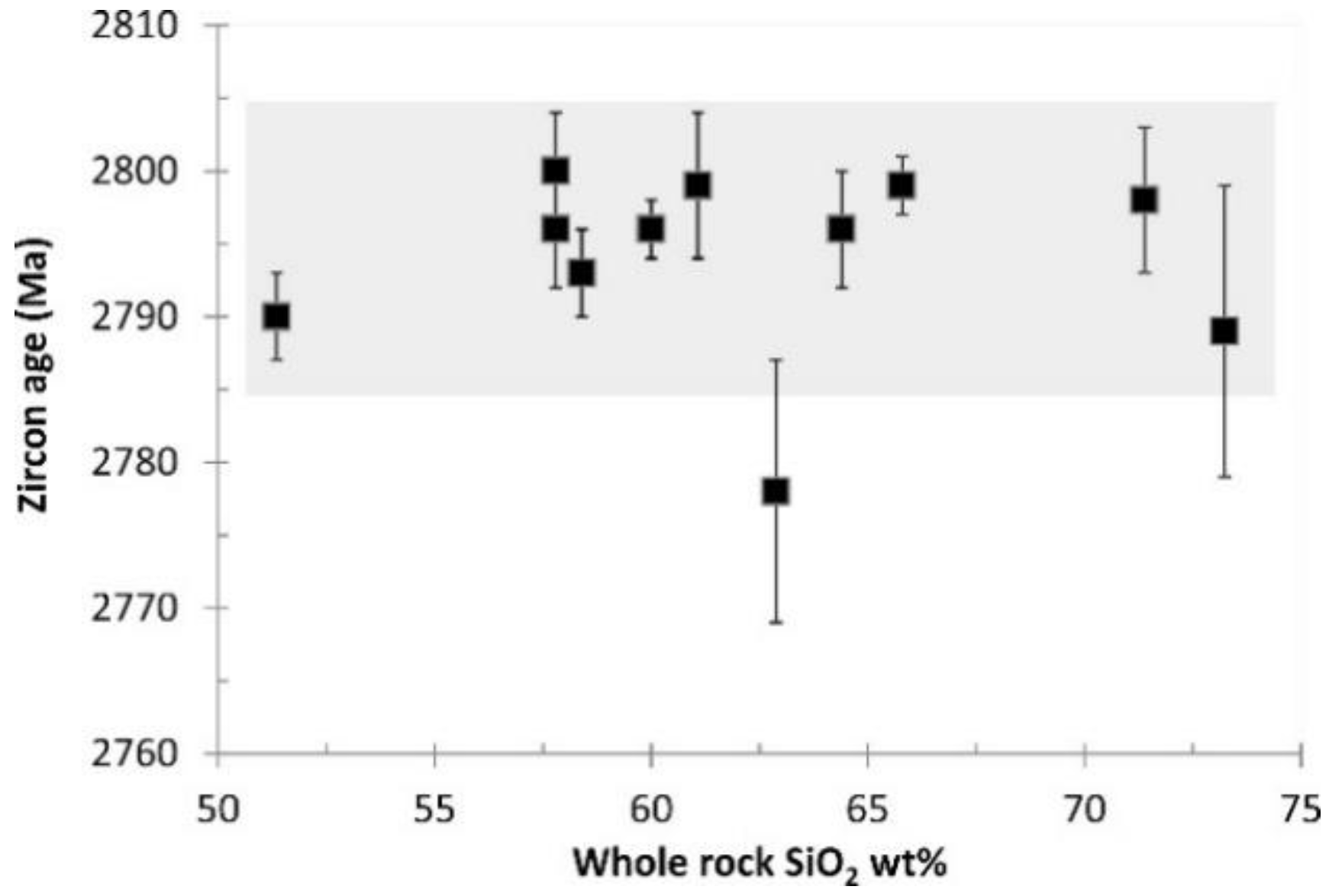

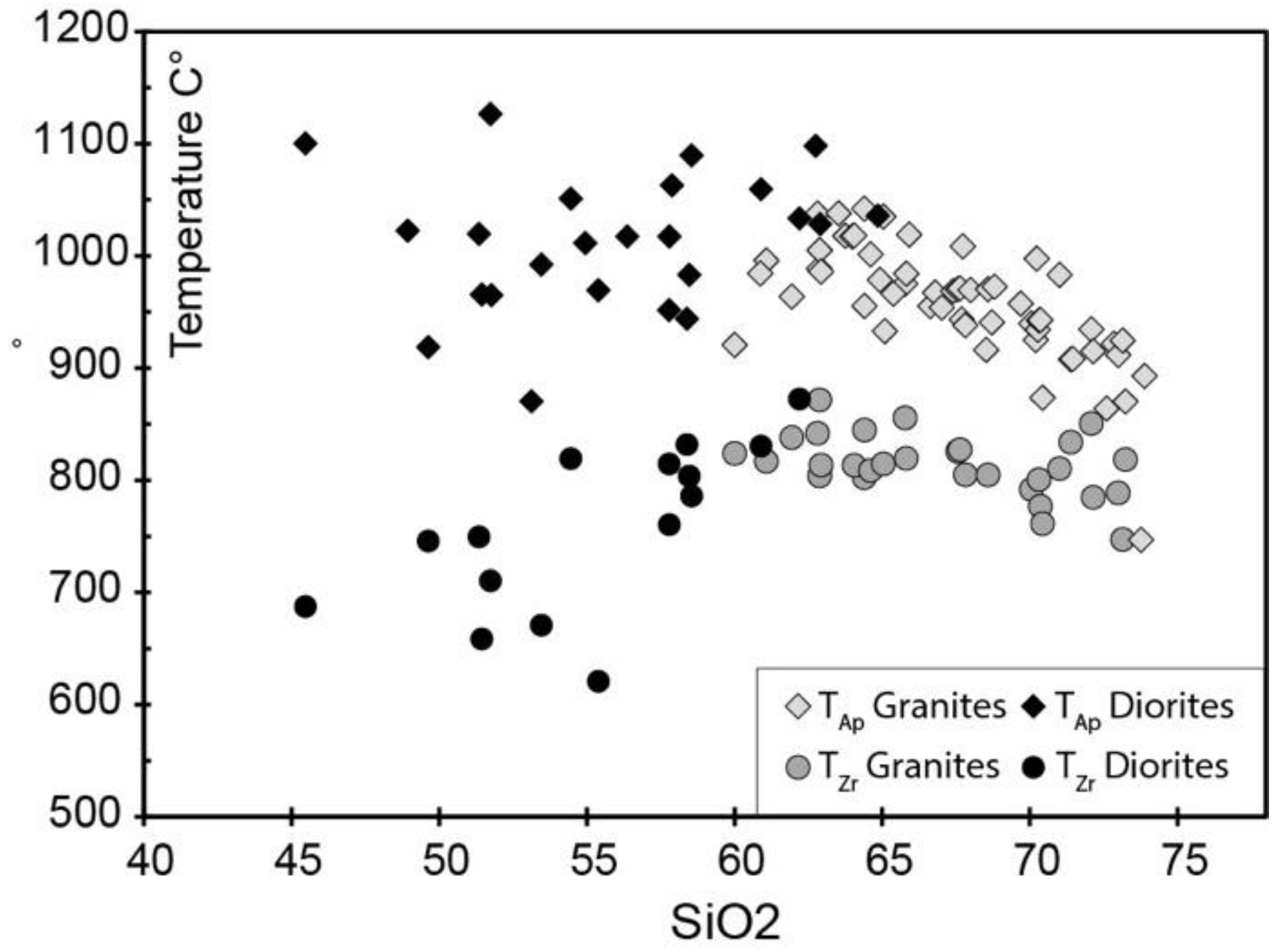
© 2018 by the authors. Licensee MDPI, Basel, Switzerland. This article is an open access article distributed under the terms and conditions of the Creative Commons Attribution (CC BY) license (http://creativecommons.org/licenses/by/4.0/).
Share and Cite
Næraa, T.; Kokfelt, T.F.; Scherstén, A.; Petersson, A. The ca. 2785–2805 Ma High Temperature Ilivertalik Intrusive Complex of Southern West Greenland. Geosciences 2018, 8, 319. https://doi.org/10.3390/geosciences8090319
Næraa T, Kokfelt TF, Scherstén A, Petersson A. The ca. 2785–2805 Ma High Temperature Ilivertalik Intrusive Complex of Southern West Greenland. Geosciences. 2018; 8(9):319. https://doi.org/10.3390/geosciences8090319
Chicago/Turabian StyleNæraa, Tomas, Thomas F. Kokfelt, Anders Scherstén, and Andreas Petersson. 2018. "The ca. 2785–2805 Ma High Temperature Ilivertalik Intrusive Complex of Southern West Greenland" Geosciences 8, no. 9: 319. https://doi.org/10.3390/geosciences8090319
APA StyleNæraa, T., Kokfelt, T. F., Scherstén, A., & Petersson, A. (2018). The ca. 2785–2805 Ma High Temperature Ilivertalik Intrusive Complex of Southern West Greenland. Geosciences, 8(9), 319. https://doi.org/10.3390/geosciences8090319





